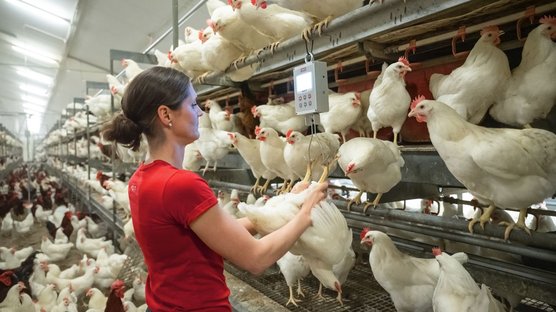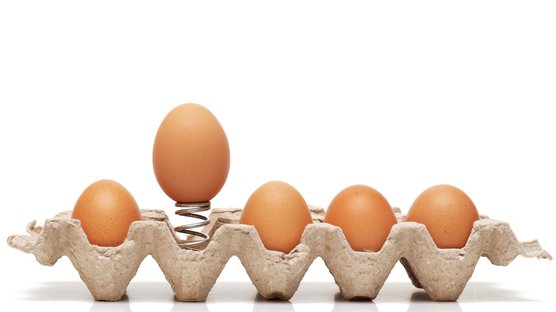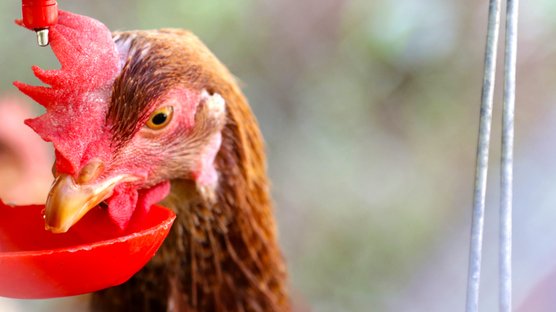
Published on June 29, 2021
Be prepared, creating the right climate for poultry
The climate inside the poultry house influences the health and wellbeing of your chicken flock. When suboptimal climatic conditions are common, it is more likely to have disorders related to the respiratory and digestive system. Next to that behavioral troubles can occur with your flock. Growth and productivity can also be negatively impacted when the climatic conditions are not met according to the standard.
The best way to measure the climate is by having a look at the chickens and the way they behave, are they active, do they eat and drink normal levels, are egg production and mortality in line with the expectations, are they visibly panting, i.e. suffering from heat stress? The climate is defined by several factors:
- House temperature
- The relative humidity
- Air movement and it’s speed
- Air composition
- Light
Always monitor and measure the climate at bird level! It can be very well possible that the climate inside the house is acceptable, but that it is unsuitable at bird level. For example: CO₂ is a heavy gas, therefor the CO₂ levels can be much higher at floor level (bird level) compared to your eye level (human level).
Another example is the temperature within the brooding rings, in the brooding rings, heat is trapped as there is less movement of ground air. This can save energy costs for heating as you need less energy to heat up the entire house. On the other hand, you need material, time and effort to install these temporarily rings.
The climate of the house can be influenced via insulating the roofs, walls and the flooring, installing ventilation, heating or cooling, and even via the lighting.
Temperature
The critical temperature for adult laying hens is 18°C. For every 1°C lower than 18°C, the birds require an extra 1 g of feed per day. The critical temperature for chicks in rearing depends heavily on the age of the chicks. Measuring the temperature is one of the most common ways to assess the climate inside the poultry house. It is easy to measure the temperature, and it does not come at a high cost. Different types of thermometers can be used, it is wise to have multiple thermometers inside the house so you can have a better view of possible temperature differences inside the house, and it is easier to find out if one got broken.
Where to place the thermometers?
First of all, place them on locations where you can easily read the temperature, i.e. do not place them too high. As the temperature inside the house is not uniform, it is advised not to place them close to the walls, as on these locations the airflow is often the lowest. Take into account the air inlets (when you have closed houses), the location of the ventilation, and of the heaters (for brooding). It is advised to place the thermometers as close as possible to the animals, this will give you the best indication of the temperature they experience. Place them in such way that the fresh air passes the thermometer prior reaching to the birds.
Heat loss in adult birds
There are two measures of temperature:
- The actual air temperature measured by the thermometer
- The effective temperature, i.e. the temperature that the bird feels. The effective temperature increases when humidity increases, but it decreases with increased air movement.
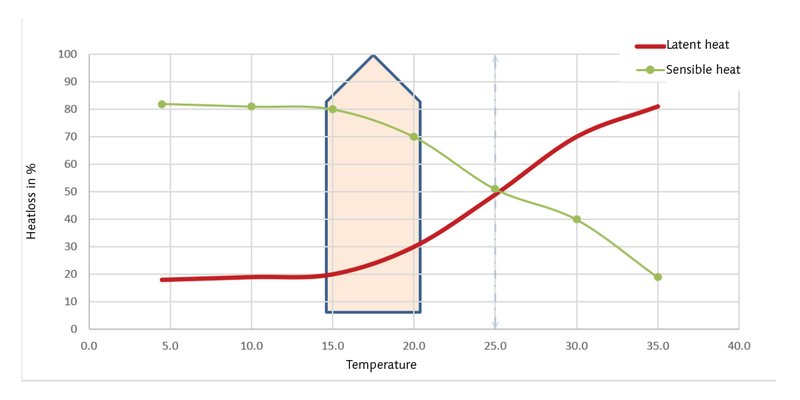
Temperature zones
The thermal neutral zone (also called comfort zone) is defined as the temperature zone in which the birds are able to keep their body temperature constant with just minimum efforts. This comfort zone depends on the environmental conditions, so always take the relative humidity into account next to temperature! From figure… you can see that the behavior of
the birds will change when barn temperatures go up. Birds will become less active, reduce their feed intake, and become fluffy whilst hanging their wings to expand the movement of air in contact with their body. As a result of the reduced feed intake, egg production and egg size can go down. If temperatures even rise further the birds will further reduce their feed intake, and they start panting in order to reduce their body temperature.
The opposite is also true, when temperatures are below the birds comfort zone, they will try to keep warm: feed intake can go up as energy from the feed can be used to keep the birds warm, and you’ll see birds huddle together to keep each other warm.
The thermoneutral zone is not fixed, it depends on several factors:
- Age
- Body weight
- Health status of the birds
- Climate in the house (temperature + relative humidity (RH) + ventilation (air velocity)
- Housing system
- Feed and feed strategies

In the thermal neutral zone, the water to feed ratio is approximately 2:1. With increasing temperatures, the birds will reduce their feed intake whilst increasing their water intake to stay cool, but also they will increase their water intake as a result of panting, panting creates even more heat through the muscle activity. When heat stress occurs, the water to feed ratio can even go up to 5:1! Not the entire increase in water usage is directly consumed, part of it is spilled as they “play” with the water and spread it over their wattles and comb in order to improve their cooling function. When severe heat stress occurs, the birds are not able to increase their water intake sufficiently, i.e. they are not able to compensate for the losses through respiration and urine excretion. Without any climatic interventions the condition may worsen, and the birds may die!
Increasing the water intake, whilst lowering the birds feed intake, will highly likely result in more wet manure with reduced quality and consistency. Large piles of wet manure can cause the relative humidity in the barn to go up, even worsening the climate in the barn. It is advised to remove the manure more often and dry it elsewhere. When keeping birds on the floor, keep in mind that the litter can produce heat as when it gets moist it starts to decompose. Caked litter should always be removed to improve the climate in the poultry house.
Relative Humidity
The relative humidity describes the level of water present in the air, i.e. if the air is holding 20% of its capacity to hold water, the humidity is 20%. When the humidity is reaching 100%, it means that the air is fully saturated. Like temperature, the relative humidity is not fixed, it can change and therefore it varies during the day. Air expands as the result of rising temperatures, therefor its moisture holding capacity increases. As a result of lower temperatures at night, the RH is generally higher during nighttime, as the colder temperature has a lower moisture holding capacity. The most dangerous period for laying hens is during the summer periods, or the hot season, and especially the late afternoon (3-6 pm). During that time, the temperature starts to decrease, but the RH is on the increase, which makes it harder for the birds to get rid of their heat. Most losses due to heat stress occur during this time of the day.
The relationship between temperature and Relative Humidity
In many cases, egg producers are focused too much on the barn temperatures. The Relative Humidity is often overlooked. But the climate inside the barn, which defines if the bird feels comfortable or not, is the result of the interaction between the temperature and the relative humidity.
The golden standard is that the sum of the temperature and the relative humidity should be around 90.
| Sum of T °C + % RH | Results in |
|---|---|
| 90 | The birds feel comfortable |
| < 80 | Cold / poor air |
| > 100 | Sweltering (hot and humid) |
| > 115 | Fatal consequence |
| Sum of T °C + % RH | Feels like |
|---|---|
| 25°C + 45% RH = 70 | 23°C |
| 25°C + 55% RH = 80 | 24°C |
| 25°C + 65% RH = 90 | 25°C |
| 25°C + 75% RH = 100 | 26.5°C |
| 25°C + 85% RH = 110 | 28°C |
The response of a laying hen to heat stress
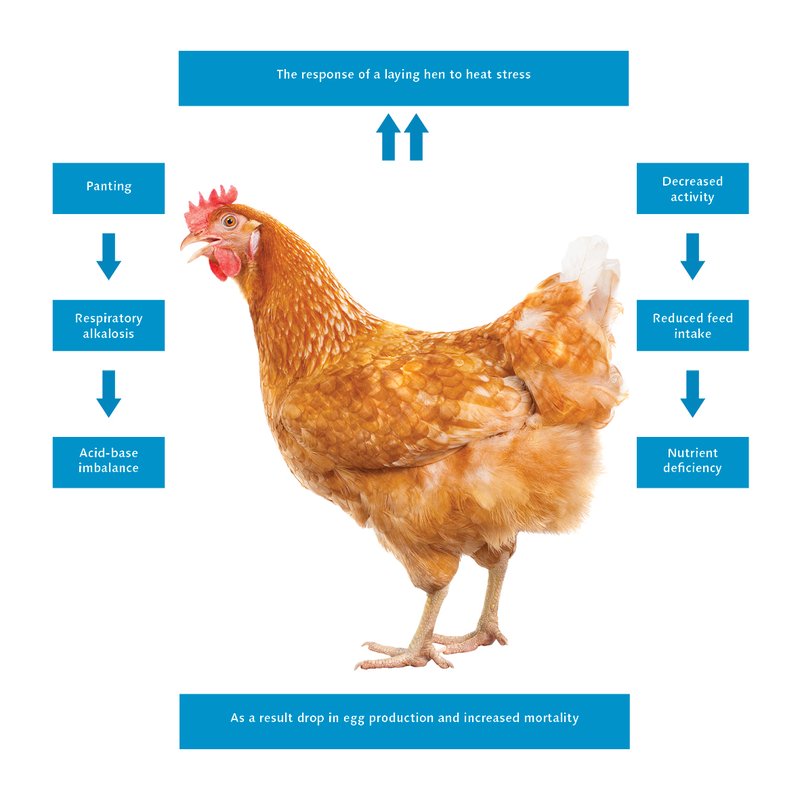
The potential of cooling
From the table that is listed below, it can be seen there are large differences in the potential for cooling for the same temperature, but for different levels of RH. It clearly demonstrates that the interaction between temperature and RH should be taken into account when you want to optimize the climate inside the house via management. The impact of high relative humidity should not be neglected, as this has a direct impact on the effect of the birds’ panting.
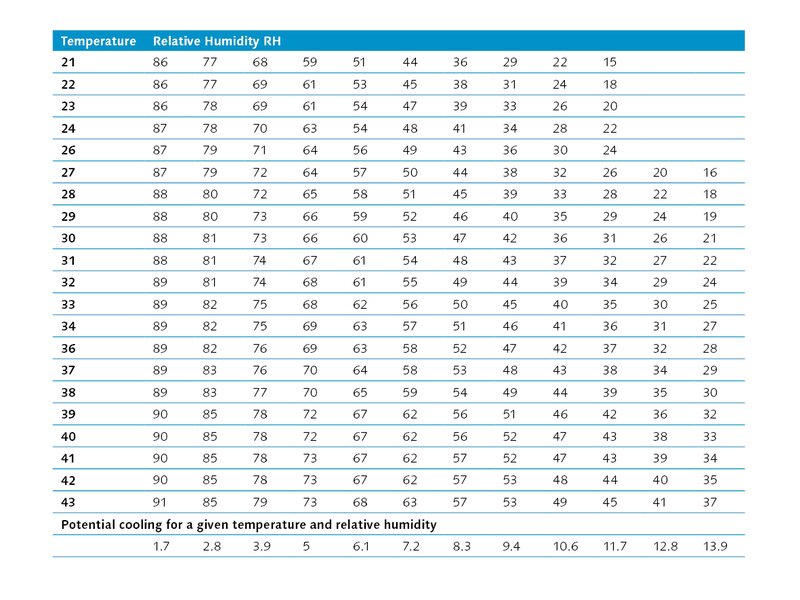
Temperature and Humidity Stress Index for Laying Hens
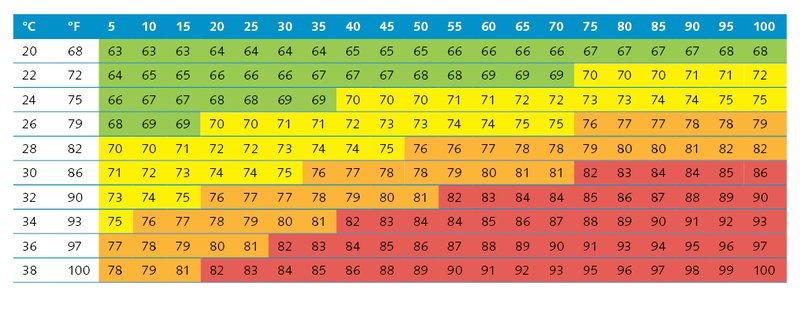
The relationship between temperature and Relative Humidity
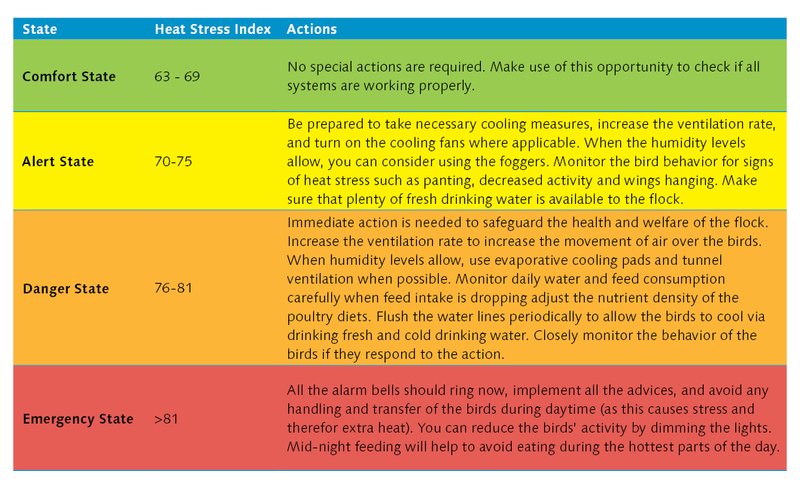
Reference: All the information on this page is based on and derived from Heat Stress Indices for Livestock, by Xin et al., (1998)
Controlling the Climate
In most countries with modern laying houses, the climate can be relatively easy controlled. It has already been taken care of in the design, i.e. insulation to prevent the heat from getting in our out, or mechanical ventilation or cooling systems that have been added. However, there are still many laying houses that lack proper climate control.
The objectives of climate control can be defined in several stages:
- To remove excess heat in the hot season
- To remove excess moisture to lower the effective temperature
- To limit the build-up of harmful gasses whilst safeguarding the supply of oxygen and fresh air
The objectives that have been stated above can be achieved using several principles. Tunnel ventilation can be very effective, to increase the flow of air, or via evaporative cooling, through fogging, or pad and fan systems.
To enable the birds to get rid of the excess of heat produced during daytime, try to lower the nighttime temperatures by 12-16°C. The lower temperature will allow the birds to recover from the heat stress experienced during the day. It is
important that during nighttime the temperature does not drop too much, as huge changes in temperature within a short period of time can negatively influence the health and wellbeing of the birds, i.e. they can easily get a cold.
The reduction in effective temperature (so the temperature felt by the bird) is called the “wind chill” factor. The birds have to deal with 2 sources of heat, heat derived from the environment, and the heat produced internally because of their metabolism. The excess heat must be elimintaed. As mentioned earlier, most of this can be lost by evaporation via panting. But panting negatively impacts the RH in the laying house. the higher the RH gets, the less effective panting becomes. Heat starts to build up in the body of the birds, and may result in birds dying because of the heat stress.

Try to block the sunlight as much as possible from entering the house, i.e. sunlight should never shine directly on the birds. Use window shades, or roof overhangs to block the sunlight from directly entering the house. Planting tall trees close to the house will create shade.
Practical and cost-effective tips
Renovating and refurbishing poultry houses to make them more resistant to heat stress can be a very costly exercise, as we understand that it can be hard to finance, we have listed several practical tips that come at low investment costs.
- The location of the house matters when we are talking about naturally ventilated houses. It is advised to construct them in an east-west direction, this will prevent the sun from shining directly into the house. besides, this location utilizes the wind the best.
- Insulation can be a very cost-effective tool in hot climates, it will prevent the heat from entering the house during daytime (radiation and conduction of solar heat), and it will prevent the heat from escaping during nighttime. Adding insulation will allow the birds to be longer in their thermal neutral zone. Bubble foil, which is covered on both sides with layers of aluminum has proven to be extremely effective in tropical conditions. Next to being effective, it is cheap to buy and easy to install. Roofs can also be covered with thatching material, like sugarcane tops, palm tree leaves, paddy straw, etc., to reduce the solar heating of the roof.
- Try to block the sunlight as much as possible from entering the house, i.e. sunlight should never shine directly on the birds. Use window shades, or roof overhangs to block the sunlight from directly entering the house. It is recommended to use porous window shades, as they will effectively block the sunlight, but allowing the air to pass through.
- A light-colored roof is better able to reflect the heat. Roofs could be painted white to allow for better reflection (hydrated lime, or white cement could be used to whitewash the roofs), for naturally ventilated houses, an open ridge allows the rising hot air to escape the house via the roof.
- Planting tall trees close to the house will create shade, as moisture from the trees will evaporate, the surrounding air will cool down, resulting in a more comfortable climate inside the poultry house. Try to plant them in such way, that they do not block the air flow. Do keep the biosecurity in mind, as trees are likely to attract wild birds and rodents. Make sure you have an effective biosecurity program in place to protect the health and wellbeing of your birds.
- Well maintained grass around houses will result in cooler conditions inside compared to bare ground, rocks or concrete. Grass will radiate less heat compared to concrete or ground.
- When you have installed cages, always make sure the feed bins are connected to the cages at the sides where the corridors are located. The coldest air can often be found in the corridors, and this will help the birds to get rid of their heat more easily.
- The water tank should preferably be stored inside, as inside it will have a lower chance to heat up via direct sunlight. When placed outside, try to protect it with wet blankets or wet jute, as the evaporation of the wet blanket/jute will always require heat. As this heat is coming from the water tank, it will keep the water inside the tank cooler. Painting your water tank white will allow better cooling of the water, as heat is reflected instead of absorbed.
- Allow for a backup power system, as the event of power outage is in general higher during hot weather/hot seasons. The impact of a power outbreak is much more detrimental in the hot season, when ventilation stops, heat stress arises, and quickly becomes fatal.
- Open sided houses can be transformed into power ventilated houses by installing curtains to the open walls. It is often cost effective and you can benefit from the advantages of both systems.
Take home message
- When heat stress occurs, focus should be mostly on management, less on nutrition
- Climate is defined by the interaction between temperature and relative humidity
- Evaporative cooling is a GO for hot and dry climates, a NO GO for hot and humid climates
- Be cautious when applying maximum ventilation for young birds as they lose heat quicker
- Adjusting the house to create a better climate for the birds can already be done on a tight budget

